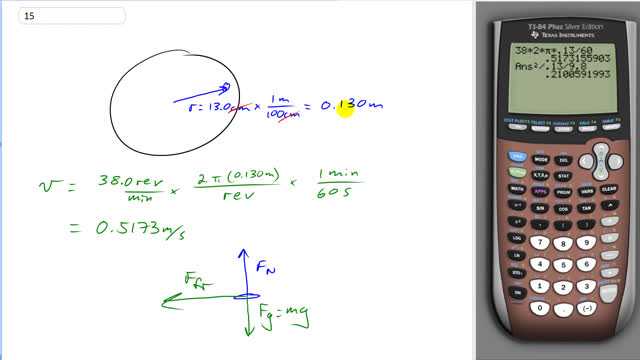
A coin is placed 13.0 cm from the axis of a rotating turntable of variable speed. When the speed of the turntable is slowly increased, the coin remains fixed on the turntable until a rate of 38.0 rpm (revolutions per minute) is reached, at which point the coin slides off. What is the coefficient of static friction between the coin and the turntable?

In order to watch this solution you need to have a subscription.
This is Giancoli Answers with Mr. Dychko. The coin resting on this turntable is going around in a circle of radius 13 centimeters, which we convert into meters by multiplying by 1 meter for every 100 centimeters, giving us 0.130 meters. And we'll turn the speed into meters per second as well by taking this 38 revolutions per minute multiplying it by 1 circumference for every revolution, that's 2πr meters per revolution; revolutions cancel giving us meters, and then times by 1 minute for every 60 seconds and so the minutes cancel, giving us meters per second; that's 0.5173 meters per second, is the speed of the coin. And then we'd look at the coin from the edge and we see the friction force, going to the left here, is the centripetal force and we have gravity down and then there's normal force upwards, and the normal force and the gravity have to be equal to each other since there is no vertical acceleration. So the friction force is mass times acceleration but in this case, the acceleration is centripetal acceleration so we can write it, v squared over r instead of a. And we know, friction force is also coefficient of friction times normal force and the normal force is equal to gravity because there's no vertical acceleration And so, since this equals friction and this equal friction, we can say these two are equal to each other. So μmg equals m v squared over r. And we'll solve for coefficient of friction; I put a little s there, in the subscript, because it's static friction since it's not actually sliding on the turntable. Divide both sides by m, divide both sides by g and we get coefficient of friction is v squared over r g. So that's 0.5173 meters per second; square that and divide by 0.130 meters times 9.8 meters per second squared which gives 0.210, for the coefficient of friction.
im getting 197.694 how did u calculate 0.210
Hi mr.robmulero, a coefficient of friction is usually less than one, and never significantly more than one. The only way to get more than one is if there's some kind of sticky glue between the surfaces to make friction more than the normal force. In any case your answer of 197.694 isn't what is expected for a coefficient of friction. As for how I calculated 0.210, I'm not really sure what precisely your question is, so if you can be more specific I might be able to help. Have you tried putting the last formula in the video into your calculator?
All the best,
Mr. Dychko